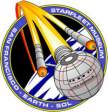 |
 |
Kestrel Class and Aryabhatta Class
![]() Diagrams
Diagrams![]()
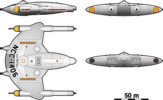 Kestrel class |
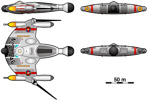 Aryabhatta class |
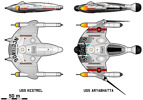 Kestrel and Aryabhatta |
 Kestrel deck plans, part 1 created by Allen Rolfes (see notes) |
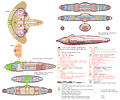 Kestrel deck plans, part 2 created by Allen Rolfes (see notes) |
|
 Aryabhatta deck plans, part 1 created by Allen Rolfes (see notes) |
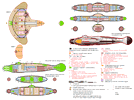 Aryabhatta deck plans, part 2 created by Allen Rolfes (see notes) |
![]() Scenes
Scenes![]()
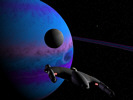 Approaching a ring planet created by Thomas Pemberton |
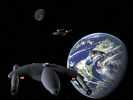 Rendezvous with Lancaster created by Thomas Pemberton |
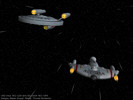 USS Lowell with USS Ursus created by Thomas Pemberton |
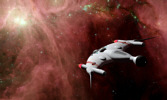 Aryabhatta exploring a Nebula created by Thomas Pemberton |
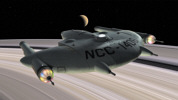 USS Kestrel at Saturn created by Jan Seebald |
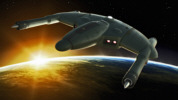 USS Kestrel and the rising sun created by Jan Seebald |
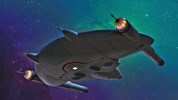 USS Kestrel in turquoise space created by Jan Seebald |
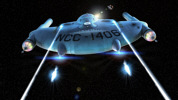 USS Kestrel fighting Orions created by Jan Seebald |
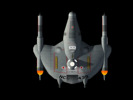 3D model for SF Command created by Chris Harris |
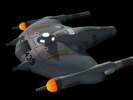 3D model for SF Command created by Chris Harris |
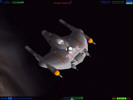 3D scene from SF Command created by Chris Harris |
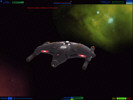 3D scene from SF Command created by Chris Harris |
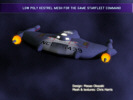 3D scene from SF Command created by Chris Harris |
![]() History
History![]()
In the first decades of the 23rd century, Starfleet starship designs generally reflected the philosophy that "bigger is better." This belief was grounded in the experiences of veterans of the Earth-Romulan War (2156 to 2160) who had learned firsthand as United Earth Stellar Navy (UESN) Academy cadets and junior officers how the mighty, half-million-ton dreadnoughts of the UESN had smashed the bloated, underpowered gasbags that made up the Romulan fleet. These young men and women had risen to command the most powerful fleet in known space and were determined to maintain that superiority against rivals then known or foreseen. Doing so required ships of ever greater speed, endurance, and firepower. This philosophy was typified by the ships of the Lancaster and Questzalcoatl classes, which had entered service in 2205 and 2215, respectively. Both classes were large battleships with immensely powerful reactors designed for high-speed, long-duration cruises. They mounted overwhelming weaponry and extremely robust shielding that ensured superiority in ship-to-ship combat. These mighty ships had been designed to penetrate deep into hostile territory, to engage enemy battle fleets, and to ultimately prevail through an overwhelming concentration of firepower. This strategy had proven effective in the Earth-Romulan War of the previous century and still guided the Federation's military planning in the early 23rd century.
However, the strategic environment had undergone enormous changes since the end of the Earth-Romulan War. In the early 2160s, large numbers of decommissioned medium and heavy cruisers had helped fuel an exuberant period of colonization beyond the core worlds of the Federation. By 2220, the Federation comprised some 35 member systems and hundreds of colonies, all of which needed to be defended. Although Starfleet Command had hoped its powerful Lancaster-class cruisers and Questzalcoatl-class semidreadnoughts could pacify large volumes of space and deter aggression by their very presence, border incursions, smuggling, and raids on outlying Federation colonies still occurred with alarming frequency. Because these powerful ships were extremely expensive to build, operate, and maintain, sufficient numbers were never available to patrol the ever expanding borders of the Federation. In numerous instances, raiders or smugglers successfully lured a sector's single Lancaster or Questzalcoatl in one direction while carrying out a cross-border raid in another. Therefore, the strengths of a battleship—speed, power, and endurance—were strategic liabilities in ships required to monitor and patrol the vast borders of the Federation.
By 2221, the growing costs of defending these scores of new colonies led to a Starfleet Command Directive calling for the development of large numbers of light cruisers, destroyers, and scouts at or near preexisting colonies along borders with potentially hostile powers. Such ships could quickly challenge and investigate each incursion and summon reinforcements, in the form of heavy cruisers held in reserve areas, when necessary. However, a more economical cruiser to replace the Lancaster and Questzalcoatl classes was not expected to be ready for at least another 5 years. Indeed, Valley Forge cruisers were not to enter service until 2227. Until that time, Starfleet had to rely upon older light cruisers of the Paris class (NCC-882), which had originally been scheduled for withdrawal from front-line service in 2223, and units of the obsolete Moskva class (NCC-374) which had entered service in 2179 and were reactivated after being mothballed at the Qualor II Starfleet Storage and Disposition Center.
A solution to this dilemma came from an unexpected quarter: Starfleet's Exploratory Command. The old United Earth Space Probe Agency (UESPA) had hoped that the end of the Romulan War would ensure its future as a service independent of the UESN. Instead, with the establishment of the United Federation of Planets' Starfleet, the UESPA was again yoked to the UESN, this time as a restraint upon any militarist tendencies. Although Exploratory Command and Tactical Command generally received equal levels of funding through the mid-2190s, by the turn of the 23rd century, some 70% of Starfleet appropriations was devoted to military programs. As the 2210s drew to a close, no new dedicated exploratory cruisers had been appropriated for service with Starfleet for over 15 years. Instead, Exploratory Command were forced to make due with obsolete cruisers transferred from Tactical Command. However, these cruisers were often too large, too expensive, and too old to perform missions for the perpetually underfunded Exploratory Command. In addition, they usually required extensive, expensive modification in drydock to prepare them for service with Exploratory Command. Heavy cruisers of the time (and, indeed, present-day explorer-type vessels, such as those of the Galaxy class), carried extensive life-support machinery and ships stores to enable five-year-long missions without refueling or replenishment from starbases or support vessels. However, as starship cruising speeds increased and expansion of the Federation met with resistance from friendly, neutral, and hostile powers, unsupported exploratory missions rarely lasted more than two years. What Exploratory Command needed were smaller, dedicated exploratory cruisers they could design from the keel up. With Earth-based companies either unwilling or unable to abandon more-profitable large cruisers to construct smaller ships, Exploratory Command turned to the Andorians.
In 2218, the Andorian ship-building industry was in dire straits indeed. During each year of the Earth-Romulan War, naval ship yards in orbit about the Andorian core worlds had churned out ships of local design totaling several million tons' displacement. However, after 2161 few Andorian designs found favor with the new Starfleet as large, more advanced ships with widely separated primary and secondary hulls designed on Earth were preferred for reasons of safety, performance, and flexibility. In contrast, Andorian ships usually combined all ship's equipment into a single hull (occasionally with an abbreviated secondary hull) with integrated nacelles. Earth's attempted embargo on matter/antimatter (M/AM) reactor technology after the war, of course, did nothing to advance starship development on Andor.
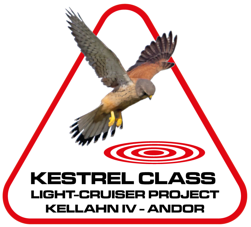

In 2218, work on the Aryabhatta-class scout project was quietly begun on Andor. Exploratory Command had finally convinced the Federation Council that a new class of dedicated explorers would be more effective and less expensive to build, operate, and maintain than would a rag-tag fleet of converted, obsolete military cruisers. The only stipulation was that construction of this new class would in no way interfere with the introduction of the projected new Valley Forge-class cruiser, whose specifications were not even to be set until 2223, at the earliest. Ten scouts of the Aryabhatta class were authorized.
Generally free of interference from Tactical Command and the Federation Council, the design stage of the Aryabhatta project proceeded extremely smoothly. The new exploratory cruiser was to have a displacement of some 70,000 tons. The drive system included a SSWR-X reactor and Apollo IV nacelles mounted outboard on the winglike primary hull. The reactors and nacelles, both of Earth design, were to allow a sustained speed of wf 5.3 and a top speed of wf 6.9, which were similar to those of military cruisers introduced several years earlier. The primary hull was a thick, rounded crescent, which housed most of the crew spaces, computer core, life-support machinery, scientific equipment, and deuterium tanks. The broad upper and lower surfaces of the primary hull supported sensor panels and antennas for short- and long-range scanning. The short, rounded secondary hull housed the shuttlecraft bay with dorsal access, the M/AM reactor, and additional scientific equipment and ended with a 16-m-diameter caudal bulb containing a long-range, omnidirectional scanner. Shielding and weaponry were minimal. Unsupported endurance was two years.
As final preparations were being made for Aryabhatta's constructor's trials in February 2221, Starfleet issued its Command Directive calling for the centrifugal basing of scouts and light cruisers. Because no other new ships of these types could be designed and constructed before 2224, Tactical Command persuaded Starfleet Command that the security of the Federation would best be served by quickly militarizing the Aryabhatta class. These new light cruisers, to be called Kestrels (NCC-1406) were to mount a more powerful drive system and stronger offensive and defensive weaponry. Tactical Command estimated that if production were divided between Human and Andorian shipyards, delivery of a class of 30 ships could begin in mid- to late 2222 and be completed within 3 years. Exploratory Command was, of course, incensed, but because of its chronic lack of support in the Federation Council, had no choice but to comply with the decision. However, a compromise was reached in which 5 of the 15 ships produced at Andorian yards and 10 of the 30 ships produced at Human yards would be Aryabhatta scouts built to original specifications; the remaining 10 Andor-built ships and 20 Earth-built ships would be Kestrels. Therefore, Exploratory Command would eventually receive 15 Aryabhattas rather than the 10 originally planned, although delivery was to be extended over 3 years rather than 18 months.
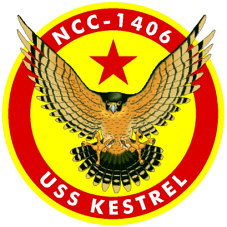
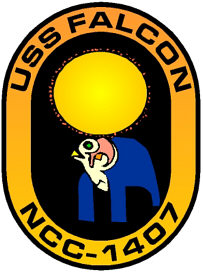
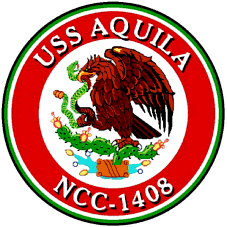
Kestrel-class cruisers carried the upgraded SSWR-X-A reactor and scaled-down versions of the new Merlin nacelles (designed for the upcoming Valley Forge class), which were better able to achieve high warp speeds on demand (maximum, wf 7.4) as well as higher cruising speeds (wf 5.5). Weaponry included phaser cannons and the newly-developed photon torpedo. Both energetic and physical shielding were increased to withstand sustained phaser volleys and nuclear warhead detonations. Most scientific facilities were removed to increase spaces for munitions, shield generators, damage control, a larger sickbay with casualty center, and a more powerful, more dynamic impulse drive. The exploratory bridge module with an emphasis on science stations was replaced with a combat bridge with high capacity links to weapons-control processors and target acquisition sensors. The low draft typical of "neckless" Andorian designs and the extensive countermeasures suite contributed to Kestrel's small sensor profile. Long-range passive sensors allowed Kestrel to quietly scan extensive areas of the frontier for enemy raiders and scoutships. Unsupported endurance was approximately 6 months.
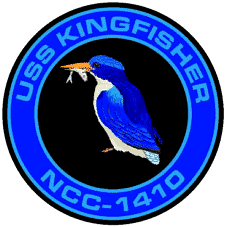
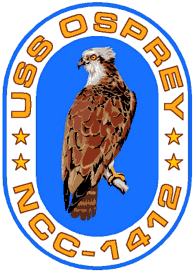
The lead ship of the new class, USS Kestrel (NCC-1406), entered service with Tactical Command in February 2223. By December 2223, 8 Kestrels had joined Starfleet. Most were sent to patrol the Federation's borders with the Klingon and Romulan Empires. Working with the Lancaster- and Quetzalcoatl-class cruisers already on station, the Kestrels formed the outer shell of the Federation's defensive sphere. Because they were small, stealthy, and less expensive to maintain, Kestrels were well suited to silently monitoring border areas for raiders and smugglers. Kestrels immediately became popular with crews for their powerful weaponry, robust shielding, and agility at both warp and impulse speeds. They were also popular with the starship buffs in the general public. Reports in the popular press likened Kestrel to a energetic snapping turtle: fast and well-armored with a nasty bite.
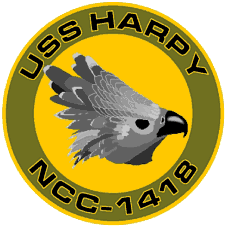
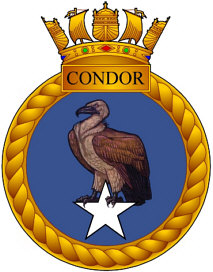
At the January 2225 combined fleet exercises near Wolf 359, a team of 6 Kestrels was able to prevent various combinations of 3 Lancaster cruisers from achieving orbit around the system's second planet within the allotted time. They employed newly developed destroyer squadron tactics based on the work of the fabled 20th century United States Navy commander Arleigh Burke and modifications of Andorian "antiparallel" weaving attacks. These exercises showed that faster and more maneuverable, although more lightly armed, Kestrels could impede or halt advances by larger, more heavily armed ships.
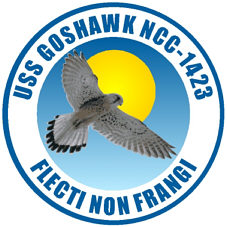
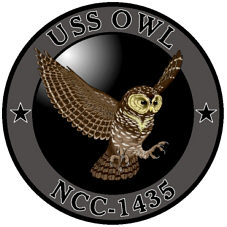
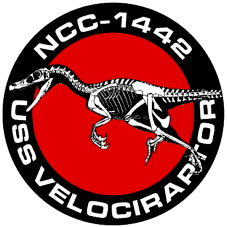
An April 2226 action against Kzinti raiders in the Little Crescent sector is typical of yeomanly service provided by Kestrels along the Federation frontier. After an automated border monitoring station reported a distant sensor contact with a group of at least four ships of unidentified type, USS Caudiptyrex (NCC-1411) and USS Goshawk (NCC-1423) were sent to investigate. They soon discovered six Kzinti "Chak-Chuf" heavy cruisers en route to the Federation colony on Slavin H-3. By harrying the Kzinti ships with alternating attack and suppression runs, the two Kestrels slowly yielded space while inflicting considerable damage on the Kzinti. These delaying actions continued for some 50 hours until USS Marduk (NCC-1281, Quetzalcoatl class) and USS Pearson (NCC-1220, Lancaster class) arrived from Starbase 15 and began to engage the Kzinti. Five of the already weakened invaders were soon destroyed, and the badly damaged sixth ship surrendered. After Starfleet damage-control teams boarded and shut down her reactor, the Kzinti ship was tractored back to Starbase 15. During their courageous defensive actions, the Kestrels were struck at least 25 times each by enemy phaser fire; however, serious casualties were avoided because of the ships' robust rodinium hull plating and quickly regenerating energetic shielding. Both Caudiptyrex and Goshawk were able to return under their own power to Starstation Nike, where they underwent three months of repairs in drydock before returning to duty. These and similar engagements are reflected in Goshawk's motto: "Flecti non frangi," meaning "To be bent but not broken."

Kestrel cruisers were also extremely effective in countering piracy and smuggling. Since ships and crews were almost always stationed along the same sectors of the border, they became extremely adept at recognizing any subspace or normal-space anomalies possibly indicating an attempt to cross the border, even by stealthed ships. Starting in the 2220s, many of the patrols in the northern sectors of Federation space were dedicated to preventing smuggling and piracy by the Orion Syndicate. Although preying on Federation shipping was always a profitable enterprise, selling commodities illegal in the Federation to willing Federation citizens was more lucrative and far less dangerous. This smuggling was aided and abetted in some sectors by corrupt Federation officials, who were only too willing to share the profit on sales of green Orion slave women, Janus stones, the narcotic klis-maklis, and Droomian flame vipers. Kestrels also policed the Federation border to prevent smuggling out of the Federation. This was necessary in 2229 when Federation citizens began to arm both sides in an increasingly bloody civil war in the A Jej system. After Kestrels intercepted numerous merchantmen carrying laser rifles, personal armor, hover tanks, atomic warheads, intercontinental missiles, gravitic mines, and hunter/killer drones, Federation diplomats were able to negotiate an end to the fighting. (The A Jej system joined the Federation in 2282.)
Exploratory Command received USS Aryabhatta (renumbered NCC-1446), the original lead ship of the class in March 2222. The last of the remaining 14 cruisers was delivered in June 2225. Despite the longer than expected wait, Exploratory Command was extremely pleased with the new class, as it fulfilled all its wishes as a medium-range exploratory cruiser. Because of their relatively short endurance of 2 years, Aryabhattas were primarily used to survey areas within Federation territory, often more than a century after such areas had first been mapped by Human or Vulcan survey ships. Longer-range missions beyond Federation borders were chiefly the job of larger ships, such as those of the Horizon and Valley Forge classes. In their more than 30 years of service, Aryabhattas are credited with mapping and exploring more than 500 star systems and establishing contact with 31 civilizations, including the Trohii, the Min, the Roffoman, and the Bet'tag. Although Aryabhattas served almost exclusively within areas nominally under Federation control, their missions were not without danger. In 2234 USS Omar Khayyam (NCC-1456) was severely damaged and lost 7 crewmen after being fired upon by the Ghonta during a first contact attempt that went awry. (The Ghonta joined the Federation in 2265.)
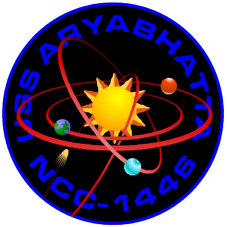
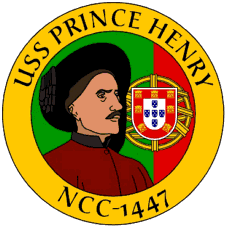
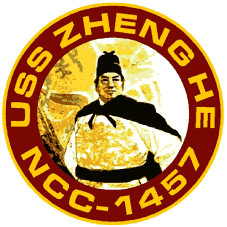
Although the Aryabhatta and Kestrel classes were not the fastest, most numerous, or most heavily armed ships of the early 23rd century, they had several important effects, which are still being felt today. First, they had distinguished careers in their respective fields: exploration and defense of the Federation. Second, their construction revived the then-moribund Andorian ship-building industry, which is now one of the most important within the Federation. Finally, the success of these classes led to ships of similar layout (nacelles attached to primary hulls) finding favor with Starfleet. This layout continues to be popular until the present day, as evidenced by the Defiant, Steamrunner, and Saber classes.
The Kestrel-class light cruiser USS Shrike (NCC-1434) and the Aryabhatta-class scout USS Prince Henry (NCC-1447) are on display at the Starfleet Museum.
![]() Commissioned Kestrel-Class Ships
Commissioned Kestrel-Class Ships![]()
| USS Kestrel NCC-1406 USS Falcon NCC-1407 USS Aquila NCC-1408 USS Warhawk NCC-1409 USS Kingfisher NCC-1410 USS Caudiptyrex NCC-1411 USS Osprey NCC-1412 USS Vulture NCC-1413 USS Pelecyornis NCC-1414 USS Harrier NCC-1415 USS Roc NCC-1416 USS Diornis NCC-1417 USS Harpy NCC-1418 USS Condor NCC-1419 USS Krechet NCC-1420 |
USS Deinonychus NCC-1421 USS Kite NCC-1422 USS Goshawk NCC-1423 USS Accipiter NCC-1429 USS Pterodactyl NCC-1430 USS Rhamphorhynchus NCC-1431 USS Mononykus NCC-1432 USS Shrike NCC-1434 USS Owl NCC-1435 USS Peregrine NCC-1436 USS Merlin NCC-1439 USS Velociraptor NCC-1442 USS Skua NCC-1443 USS Hobby NCC-1444 USS Sparrowhawk NCC-1445 |
![]() Commissioned Aryabhatta-Class Ships
Commissioned Aryabhatta-Class Ships![]()
| USS Aryabhatta NCC-1446 USS Prince Henry NCC-1447 USS John Burke NCC-1448 USS Van Allen NCC-1449 USS Herschel NCC-1450 USS Huygens NCC-1451 USS Kepler NCC-1452 USS Lagrange NCC-1453 |
USS Lowell NCC-1454 USS Maury NCC-1455 USS Omar Khayyam NCC-1456 USS Zheng He NCC-1457 USS Lewis and Clark NCC-1458 USS Amundsen NCC-1459 USS Aristarchus NCC-1460 |
![]() Kestrel-class Specifications
Kestrel-class Specifications![]()
Standard displacement: 69,480 t
| Overall | 1° Hull | 2° Hull | Nacelles | |
| Length [m] | 111.60 | 70.51 | 68.47 | 100.00 |
| Beam [m] | 112.44 | 112.44 | 24.95 | 8.42 |
| Draft [m] | 22.13 | 22.13 | 18.24 | 8.42 |
Crew complement: 175 (28 officers + 147 crew)
Weapons: 6 Type V phaser turrets (6 × 1 mounts), 2 Type VI phaser cannons (fixed mounts), 2 torpedo tubes with 24 Mark II photon torpedoes
Embarked craft: 2 light cargo/personnel shuttlecraft, 2 personnel shuttlepods
Warp drive: SSWR-X-A spherical cavity M/AM reactor with 2 Merlin I nacelles
Velocity: wf 5.5, cruise; wf 7.1, supercruise; wf 7.4, maximum
Units commissioned: 30
![]() Aryabhatta-class Specifications
Aryabhatta-class Specifications![]()
Standard displacement: 75,111 t
| Overall | 1° Hull | 2° Hull | Nacelles | |
| Length [m] | 129.29 | 76.21 | 87.53 | 89.04 |
| Beam [m] | 116.04 | 116.04 | 24.95 | 9.70 |
| Draft [m] | 22.13 | 22.13 | 18.24 | 9.70 |
Crew complement: 194 (35 officers + 159 crew)
Weapons: 4 Type V phaser turrets (4 × 1 mounts)
Embarked craft: 2 light cargo/personnel shuttlecraft, 4 personnel shuttlepods
Warp drive: SSWR-X-B spherical cavity M/AM reactor with 2 Apollo IV nacelles
Velocity: wf 5.3, cruise; wf 6.6, supercruise; wf 6.9, maximum
Units commissioned: 15
![]()